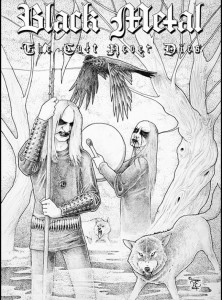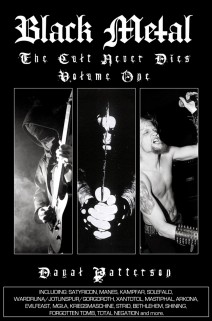 There’s a good chance you have already hungrily devoured Black Metal – Evolution Of The Cult, the authoritative tome and the most essential book on the genre in years, released at the tail end of 2013. If not you should immediately remedy that situation and be prepared to grab this new book which the author has penned too, due to the fact that this is very much a continuing story and other facets and groups that did not make the original book have plenty of scope and reason to be explored. Dayal has released this on the Cult Never Dies publishing house he founded this time giving himself complete creative control, which is both a wise and no doubt financially very brave way of doing things.
There’s a good chance you have already hungrily devoured Black Metal – Evolution Of The Cult, the authoritative tome and the most essential book on the genre in years, released at the tail end of 2013. If not you should immediately remedy that situation and be prepared to grab this new book which the author has penned too, due to the fact that this is very much a continuing story and other facets and groups that did not make the original book have plenty of scope and reason to be explored. Dayal has released this on the Cult Never Dies publishing house he founded this time giving himself complete creative control, which is both a wise and no doubt financially very brave way of doing things.
Essentially the book, once you can stop gazing at the striking cover art by Gareth Elliot (for the limited first edition), is divided into three distinct sections; ‘Norway Revisited’, ‘Polish Black Metal’ and ‘Depressive Black Metal.’ This immediately presents quite a bit of diversity and covers areas that should be of interest to everyone as well as allowing more in depth exploration of things with the people that defined the areas and atmospheres within the music. Dayal has, as the first book clearly illustrated, gained a huge amount of respect from all the people involved in making the music itself in his first volume and the years spent as a journalist in various well recognised publications. This is where this book again ultimately succeeds as it is not a case of someone surmising what has been going on from the outside but a flowing narrative of what actually occurred by the people behind it. This has led to some of the interviewees here coming out of complete enshrouded obscurity to speak truthfully and honestly like they never have before and in the case of one band Silencer Dayal has managed to get Leere, one half of this obscure act to break their silence (sorry) for the very first time.
The Norwegian section starts off on somewhat safe ground with a large chapter on Satyricon, a band that even those with only a passing interest in black metal should be somewhat familiar with. Its fronds spread far though and take in the entire collective surrounding the band and Satyr Worngraven’s Moonfog label and is an essential tale which is not only gripping but one that goes from the genesis of the bands right up to the present day and the latest release of them playing with the Norwegian National opera, something that would never have been anticipated and no doubt looked at with incredulity back at the emergence of this church burning scene in Norway. It really does show how everything has in a way come round full circle. This is also something apparent with the chapter focussing on the relatively new Wardruna, a group that despite the notorious Gaahl being involved in, one whose national acceptance remains a strange parallel to the days of old. Some of my favourite personal bands such as Kampfar and Solefald get a chapter and the way the writing flows makes the journeys that they undertook easy to process even when the band’s stories are complex and convoluted. Dayal asks the right questions allowing the participants to take up the main voice but he is also on hand here to describe the nuances of the actual music itself from release to release making it easy to comprehend, certainly for those that have not heard the groups before. Although some of these are bigger acts within the scene there are likely to be group’s that have not been heard by readers before and this will no doubt make them very keen to check them out. This is very useful with a band like Manes who have gone through many stylised changes as they have progressed. I also found the final chapter here on artist Theodor Kittelsen incredibly insightful as it did really help explain many images that have impressed and indeed haunted on album covers for years.
 The Polish side of things was a real learning curve for me as I had not read in depth about many of the bands here anywhere else and indeed I think it is fair to say the likes of Xantotol, Mastiphal, Arkona and Evilfeast get very little press attention, certainly outside their native homeland. The bands may all have different stories but there are distinct similarities from trying to persevere and develop themselves musically within a country that was comparatively poor and with very limited resources. It seems like a lot of Polish albums turn up here for review and I am always discovering new stuff. Indeed I have some in front of me now from labels such as Godz OV war Productions who are cited in the book as being one of the forerunning Polish labels. This section really helped me fill in some of the gaps and it is a family tree that has spread far. The downside though is that it has made a shopping list of groups and albums that need to be checked out to grow substantially. The last part here focuses on Mgla and Kriegsmachine relatively newer bands and as far as the first one is concerned a hugely popular one which will certainly appeal to many. Naturally other big names within the scene are mentioned and the whole satanic and nationalistic side of things, which were quite prolific within the emerging scene are discussed by the musicians too.
The Polish side of things was a real learning curve for me as I had not read in depth about many of the bands here anywhere else and indeed I think it is fair to say the likes of Xantotol, Mastiphal, Arkona and Evilfeast get very little press attention, certainly outside their native homeland. The bands may all have different stories but there are distinct similarities from trying to persevere and develop themselves musically within a country that was comparatively poor and with very limited resources. It seems like a lot of Polish albums turn up here for review and I am always discovering new stuff. Indeed I have some in front of me now from labels such as Godz OV war Productions who are cited in the book as being one of the forerunning Polish labels. This section really helped me fill in some of the gaps and it is a family tree that has spread far. The downside though is that it has made a shopping list of groups and albums that need to be checked out to grow substantially. The last part here focuses on Mgla and Kriegsmachine relatively newer bands and as far as the first one is concerned a hugely popular one which will certainly appeal to many. Naturally other big names within the scene are mentioned and the whole satanic and nationalistic side of things, which were quite prolific within the emerging scene are discussed by the musicians too.
As far as the depressive black metal side of things are concerned the stories are ever more fascinating as the musicians give an insight into their reasons for their music and their life. In the case of Bethlehem a band I admit to never understanding or even liking particularly it is a real gritty tale and one that makes me appreciate things far more and go back and try to listen to the music with a new perspective. I am not going to explain what happened in the formative years of Jürgen Bartsch that is for you to read but it’s certainly a jaw dropping chapter. Strid and the aforementioned Silencer were also quite remarkable bands to read about and there is no way that even the biggest kvlt black metal fan in the world is going to come away from hearing about some of these bands without a better insight and understanding. Forgotten Tomb having just seen them live and reviewed the new album were of particular interest. I’m kind of glad I didn’t go up and drunkenly try and talk bollocks to Herr Morbid after reading that part. He might be arrogant but at least I can now understand why more. Interestingly here most of the interviewees have had some sort of relationship with Niklas Kvarforth and his spectre hangs heavily over the whole section.
This was a book that I found hard to put down and likewise did not want to finish which is in every respect the mark of a good read as far as I am concerned. It also came with a separate visual companion with pictures by the author and other respected photographers such as Ester Segarra and promotional press shots.
The possibilities for expanding this into an on-going series are boundless and there is no doubt a reason for the Volume 1 tag on the book. I could mention at least 10 areas that I would love to read about but that is no doubt up to Patterson to surprise us with further down the line.
For those of us living in London it should be mentioned that in conjunction with promoters Old Empire the author has helped pave the way for some ‘cult never dies’ nights and they have already scored forthcoming gigs headlined by the likes of Mastiphal and Lifelover. Here’s to many more volumes following!
(Pete Woods)
http://www.cultneverdies.com/p/black-metal-cult-never-dies-new.html

Leave a Reply